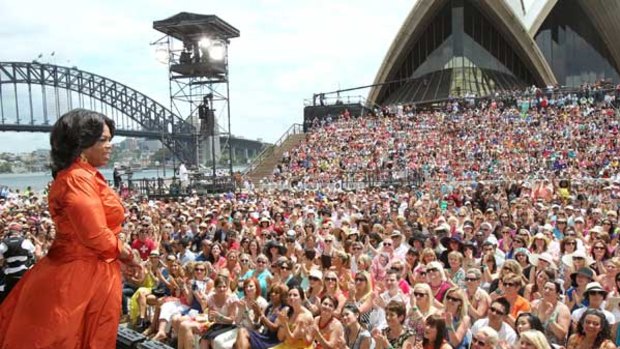
The money spent on bringing Oprah Down Under could have been better spent on the Chinese market.
I’ve done enough whingeing about Australia’s policy-free tourism strategy for 10 men. But what was I expecting when someone at Tourism Australia last year thought of the gimmick of inviting the Oprah Winfrey entourage here to tape some TV shows for overseas audiences?
Of course, I’d say we took the $5 million it cost us to the toilet and flushed it.Tourism Australia is now telling us it’s too early to make judgements: we’ll see the benefits in the next year as Americans and other potential visitors make travel plans and book Australian holidays as a result of Oprah’s flying circus around Australia.
The Sunday Age reports US arrivals for the first five months of 2011 fell by 0.8 per cent, compared with the same period last year, according to the Australian Bureau of Statistics. The dip was even more pronounced in Britain and Canada, where Winfrey's Ultimate Australian Adventure also aired in January.
Canadian arrivals from January to May 2011 fell by 5.1 per cent year on year, while British arrivals dropped by 4.6 per cent.
Meanwhile, Australia, which used to be flavour of the month in Japan and the US before that, has now been adopted as one of a range of hot new destinations by the adventure-hungry Chinese middle class, who, for the first time since the 1850s gold rush, have the money and the motivation to head Down Under by the Boeing-777-load.
Several years ago, China’s complex travel bureaucracy conferred on Australia so-called preferred destination status, which has helped open the floodgates from the Middle Kingdom, but some critics believe Australia should have spent more on developing the Chinese market.
That’s only half the problem, as far as I can see. It’s a poor advertisement for Australian tourism if the local population is deserting the place to holiday overseas in record numbers and has been scathing on blogs such as this about what they’re leaving behind.
At a summit last year on the future of the industry, Tourism Australia spoke among other things about the need to build new five-star adventure resort-style properties to cater for an expected influx of new visitors in the next decade.
But I heard nothing about the twin issues that I think dwarf all others: value for money and customer service.
For foreign visitors, Australia is never going to be a dirt-cheap holiday like Thailand or Indonesia. For a number of reasons, it has become probably the most expensive country in the world.
It has at least one of the key elements right: cheap air transport, thanks to the efforts of successive governments of both colours in enabling domestic and international competition.
But that’s where the pass marks end. While the airline part of the system is right, they’ve utterly failed consumers by producing the highest-cost airports system in the world. The savings that the airlines give to consumers are being transferred to the infrastructure funds that own the airports because the Howard Government removed price controls. The current government has done nothing to fix the situation; it gives the impression it has done nothing because it doesn’t understand the industry.
This bears on Australia’s broader economic problem. Australia has become the most expensive country on earth for tourists and locals alike and a large part of the reason, in my opinion, is the failure of national competition policy: i.e., we don’t have one.
Even in the past few months, Australian shoppers have begun voting with their laptops and mice: if they can buy it from overseas, they will to avoid anti-competitive arrangements in retailing that add to end-user prices.
State governments have been busy rubber-stamping increases in electricity and water prices with apparently few questions asked.
The Australian Competition and Consumer Commission has become a toothless tiger, which has not been given the powers to police the gate-keepers of most of our wealth: fuel companies, banks, supermarkets, insurance companies.
Tourists’ per-capita spending is down, we learned recently, even though numbers overall are up marginally. No wonder, if everything in Australia is unaffordable. Twelve dollars for a small punnet of blueberries?
The other big mother of a problem that has almost become part of the Australian DNA is lousy customer service. I don’t want you to again launch forth on this frustrating subject because, when it comes to holidaying in Australia, apparently you and I both are howling at the moon.
Any danger Tourism Australia, without attempting to re-invent the wheel, could put some time into the customer service issue?
Indeed, if its first impulse is to build more five-star, it would seem to me that Tourism Australia is part of the problem. In a high-priced country, the priority should be affordable three and four-star, it seems to me.
I thank you for all the feedback you’ve given me on these issues in the past. I don’t think it’ll make any difference if you again go to the effort because I don’t think anyone who should be is paying attention. If you do have something you think could make a difference, feel free.
Sign up for the Traveller Deals newsletter
Get exclusive travel deals delivered straight to your inbox. Sign up now.